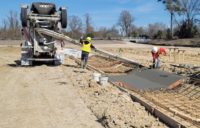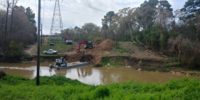Houston-area officials tasked with minimizing impacts of floods are eyeing a plan to build eight large-diameter stormwater tunnels at an estimated cost of $30 billion.
The Harris County Flood Control District recently completed its Phase 2 study on possible tunnel projects. It identified potential alignments for the eight proposed tunnels with the greatest impact in 11 of the county’s 23 watersheds, says Scott Elmer, assistant director of operations for the district. The preliminary plan calls for a total of about 132 miles of tunnels ranging from 30 feet to 40 feet in diameter and about 120 feet underground.
The study estimates the tunnels could provide an additional 76,000 cu feet per second of stormwater conveyance, eliminating between 80,000 and 120,000 cumulative instances of flooding over the tunnels’ 100-year life and during storms up to a 100-year event.
"The tunnel alternatives selected for concept refinement appear to provide a more favorable solution when compared to traditional solutions that deliver a similar level of service in terms of flood reduction benefits," states the study report, prepared by Black & Veatch. "It is anticipated that tunnel projects could be implemented within a much shorter timeframe and construction would involve reduced impacts to the community and environment when compared to traditional solutions."
Harris County, which includes Houston, is largely low-lying and flat, with slow-to-drain landscape. Storms like Hurricane Ike in 2008 and Hurricane Harvey in 2017 caused severe damage across the area, and in 2018 local voters passed a $2.5-billion bond program to fund flood risk reduction projects. The flood control district is using the money to fund hundreds of projects, including the studies for the proposed tunnels.
The preliminary plans maximize the use of public rights-of-way, Elmer says. All eight proposed tunnel alignments are primarily under existing flood control district channels, though the tunnels would need wider turn radii. While some subterranean easements and land acquisition would be needed, the tunnel plan overall uses much less surface land than what would be needed using traditional flood control methods. Elmer says the tunnel plan calls for about 35 acres, while methods like channels and retention basins would require about 3,145 acres to achieve the same impact.
“It’s a big difference, and a big impact on community cohesion, and maintaining communities that exist today,” Elmer says.
Following the Phase 1 study, which examined whether it would be possible to build large-diameter stormwater tunnels in Harris County, the $2.5-million Phase 2 study, with lead consultant Black & Veatch, used a rain-on-grid model. The team then calibrated that model against instances of reported flooding, including federal claims, damage reported by owners and the flood control district’s own post-storm assessments. They then used the results to identify “flood damage centers,” which Elmer says are the areas of concentrated repetitive flooding. To get the most benefit of the proposed tunnels, they selected alignments that would intersect those flood damage centers. They also looked at the physical characteristics of the watersheds, to determine where tunnels could convey water just by gravity.
The flood control district shared the results of the Phase 2 study with the public June 16 and is currently in a 90-day public comment period. Elmer says they will spend the rest of this year scoping the Phase 3 study. In addition to taking public feedback, he says the flood control district will confer with Port Houston to ensure the tunnels would not have an adverse impact on the Houston Ship Channel or port facilities. Environmental work is needed, and the next study will need to be federally compliant with the aim that the U.S. Army Corps of Engineers can participate in the project.
The flood control district will likely release an RFQ for a Phase 3 consultant either late this year or early next year, Elmer says. The district has $20 million set aside for the study, which they expect will take about three years. They will be looking for a firm that can assist with both engineering, to advance the design, as well as helping to build the “business case” for funding the tunnels by showing the economic benefits.
With the project’s estimated cost and scope of work, officials say the flood control district will likely need state and federal funding to get it built.
"Although the costs of a tunnel system are significant and finding partnership funding for a project of this scale is not guaranteed, we are excited about exploring tunnels as an additional tool to reduce flooding risks in Harris County," Tina Petersen, flood control district executive director, said in a statement.






Post a comment to this article
Report Abusive Comment